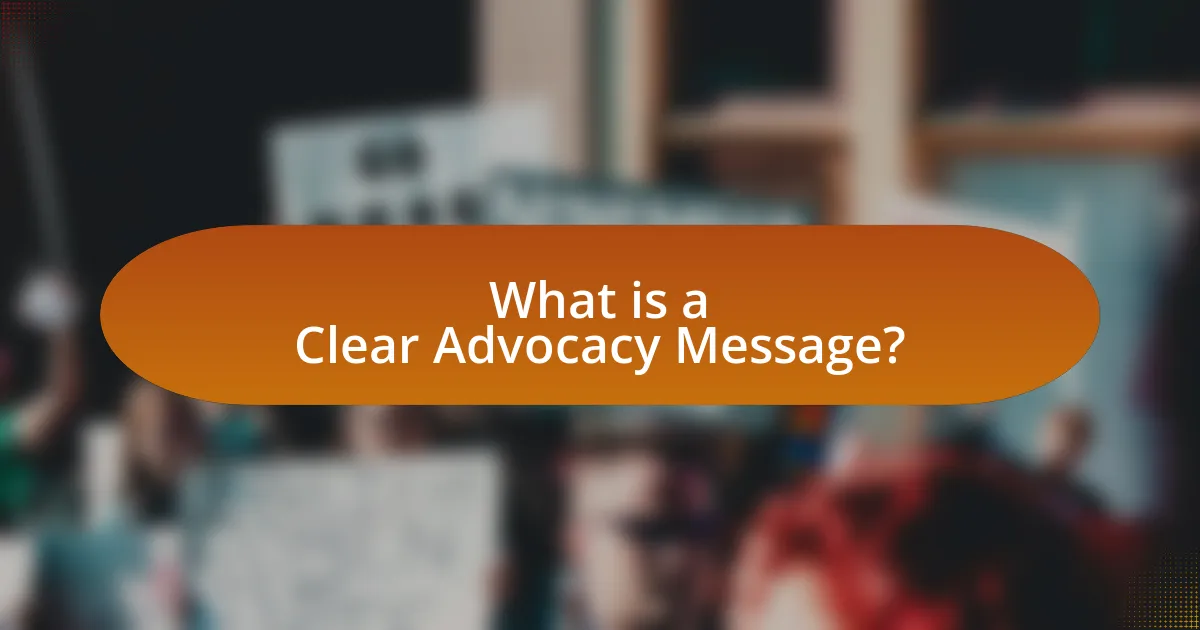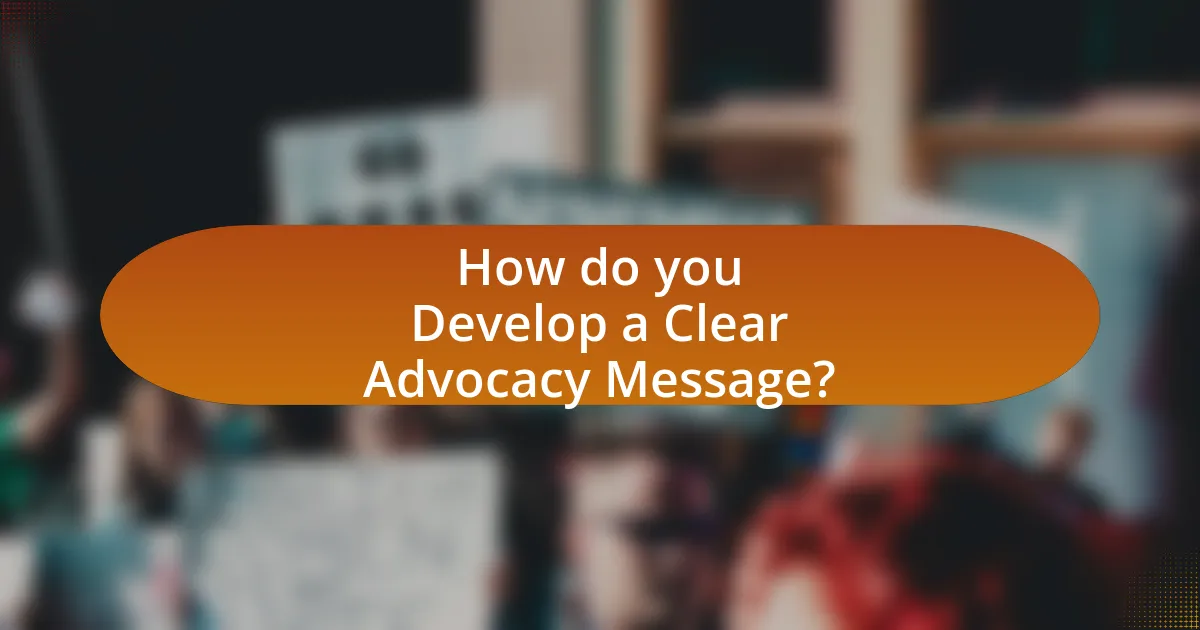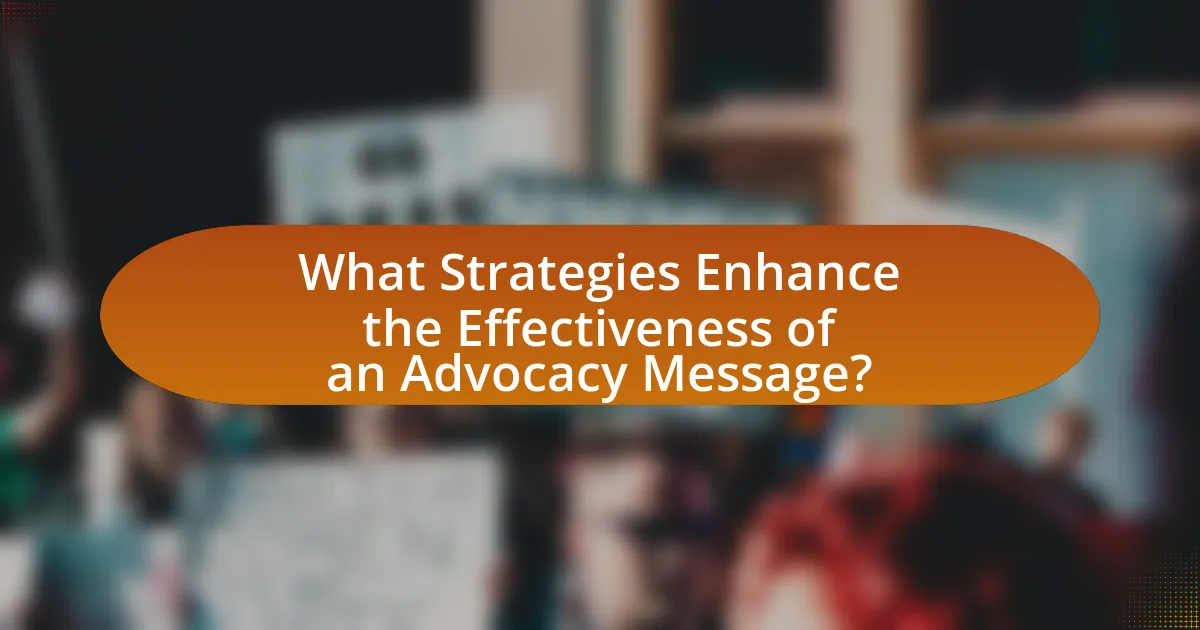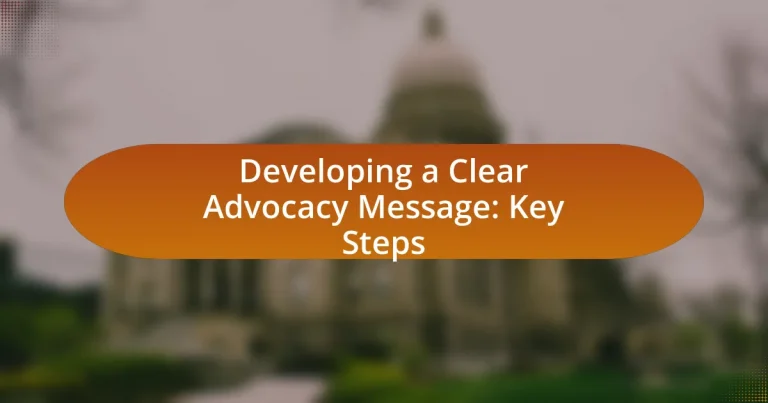A clear advocacy message is a concise statement that effectively communicates a specific position or call to action regarding an issue, essential for influencing public opinion and mobilizing support. This article outlines the importance of clarity in advocacy messaging, detailing how it enhances public perception and engagement. Key components of an effective message include a defined purpose, target audience, compelling narrative, and a call to action. The article also discusses strategies for developing a clear advocacy message, including understanding the audience, refining language for clarity, and utilizing emotional appeal and storytelling techniques to strengthen the message’s impact. Additionally, it highlights best practices for message delivery and common pitfalls to avoid, ensuring advocates can effectively communicate their goals and inspire action.

What is a Clear Advocacy Message?
A clear advocacy message is a concise and compelling statement that communicates a specific position or call to action regarding a particular issue. This type of message is essential for effectively influencing public opinion and mobilizing support, as it distills complex ideas into understandable terms. Research indicates that messages that are straightforward and emotionally resonant are more likely to engage audiences and drive action, as evidenced by studies showing that clarity enhances message retention and persuasion.
Why is a Clear Advocacy Message Important?
A clear advocacy message is important because it effectively communicates the core values and objectives of a cause, ensuring that the intended audience understands the issue at hand. This clarity helps to mobilize support, as research indicates that messages that are straightforward and focused can increase engagement and action among stakeholders. For instance, a study by the FrameWorks Institute found that clear messaging significantly enhances public understanding and support for social issues, demonstrating that clarity in advocacy can lead to more effective campaigns and policy changes.
How does a Clear Advocacy Message influence public perception?
A clear advocacy message significantly influences public perception by enhancing understanding and engagement with the issue at hand. When messages are concise and focused, they facilitate easier comprehension, allowing the audience to grasp the core arguments and motivations behind the advocacy. Research indicates that clarity in messaging can lead to increased support; for instance, a study published in the Journal of Communication found that clear and direct messages are more likely to resonate with audiences, resulting in a 30% increase in public support for the advocated cause. This demonstrates that a well-articulated message not only informs but also shapes attitudes and behaviors, ultimately swaying public opinion in favor of the advocacy goals.
What role does clarity play in advocacy effectiveness?
Clarity is essential for advocacy effectiveness as it ensures that the message is easily understood by the target audience. When advocates communicate their goals and objectives clearly, they increase the likelihood of engaging supporters and influencing decision-makers. Research indicates that messages with clear, concise language are more persuasive; for instance, a study published in the Journal of Communication found that clarity in messaging significantly enhances audience retention and response rates. Therefore, clarity not only facilitates comprehension but also strengthens the overall impact of advocacy efforts.
What are the key components of a Clear Advocacy Message?
A clear advocacy message consists of a defined purpose, a target audience, a compelling narrative, and a call to action. The defined purpose articulates the specific issue or cause being addressed, ensuring clarity in the message’s intent. Identifying the target audience allows the message to be tailored to resonate with those who have the power to effect change. A compelling narrative engages the audience emotionally and logically, often supported by facts or personal stories that illustrate the issue’s significance. Finally, a call to action provides clear steps for the audience to take, motivating them to participate in the advocacy effort. These components work together to create a cohesive and persuasive message that effectively communicates the advocacy goals.
What elements should be included in the message?
A clear advocacy message should include a compelling call to action, a concise statement of the issue, supporting evidence, and an emotional appeal. The call to action directs the audience on what steps to take, while the issue statement clearly defines the problem at hand. Supporting evidence, such as statistics or expert testimonials, reinforces the message’s credibility. Emotional appeal engages the audience on a personal level, making the message more relatable and impactful. These elements work together to create a persuasive and effective advocacy message.
How do target audiences affect message composition?
Target audiences significantly influence message composition by dictating the language, tone, and content that resonate with them. Understanding the demographics, interests, and values of the target audience allows communicators to tailor messages that are more likely to engage and persuade. For instance, research shows that messages aimed at younger audiences often utilize informal language and digital platforms, while messages for older demographics may employ more formal language and traditional media. This alignment enhances the effectiveness of the communication, as evidenced by studies indicating that targeted messaging can increase engagement rates by up to 50%.

How do you Develop a Clear Advocacy Message?
To develop a clear advocacy message, identify the core issue and articulate a concise, compelling statement that resonates with your target audience. This involves understanding the audience’s values and concerns, which allows for tailoring the message to address their specific needs. Research indicates that messages framed in a relatable context increase engagement; for instance, a study by the FrameWorks Institute found that narratives connecting personal experiences to broader social issues significantly enhance message clarity and impact. By focusing on clarity, relevance, and emotional connection, advocates can effectively communicate their message and inspire action.
What initial steps should be taken in the development process?
The initial steps in the development process include defining the advocacy message, identifying the target audience, and conducting research to understand the context and needs of that audience. Defining the advocacy message ensures clarity and focus, while identifying the target audience allows for tailored communication strategies. Conducting research provides insights into the audience’s perspectives and the broader environment, which is essential for effective advocacy. These steps are foundational for creating a compelling and relevant advocacy message that resonates with stakeholders.
How do you identify your advocacy goals?
To identify advocacy goals, one must first assess the specific issues or causes that resonate personally or align with organizational missions. This involves conducting a thorough analysis of the community needs, stakeholder interests, and existing gaps in advocacy efforts. For instance, research from the National Council of Nonprofits indicates that effective advocacy goals are often rooted in data-driven assessments of community challenges, such as health disparities or educational inequities. By prioritizing these issues based on urgency and potential impact, advocates can establish clear, actionable goals that guide their efforts and resonate with their target audience.
What research is necessary to understand your audience?
To understand your audience, conducting demographic research, psychographic analysis, and behavioral studies is essential. Demographic research identifies characteristics such as age, gender, income, and education level, which helps in segmenting the audience effectively. Psychographic analysis delves into values, interests, and lifestyles, providing insights into motivations and preferences. Behavioral studies examine how the audience interacts with content, including their purchasing habits and engagement patterns. For instance, a study by Pew Research Center highlights that understanding demographic factors can significantly enhance targeted messaging, leading to a 30% increase in engagement rates. This combination of research methods ensures a comprehensive understanding of the audience, enabling the development of tailored advocacy messages.
How can you refine your message for clarity?
To refine your message for clarity, focus on simplifying language and eliminating jargon. Clear communication requires using straightforward words and phrases that your audience can easily understand. Research indicates that messages with simpler vocabulary are more likely to be retained and comprehended; for instance, a study published in the Journal of Communication found that clarity significantly enhances audience engagement and retention. Additionally, structuring your message logically, using bullet points or numbered lists, can further enhance clarity by making key points stand out.
What techniques can be used to simplify complex ideas?
Techniques to simplify complex ideas include using analogies, breaking down information into smaller parts, employing visuals, and using clear, concise language. Analogies help relate unfamiliar concepts to familiar ones, making them easier to understand. Breaking down information into smaller, digestible parts allows the audience to grasp each component before seeing the whole picture. Visuals, such as charts or infographics, can illustrate relationships and processes, enhancing comprehension. Clear and concise language eliminates jargon and ambiguity, ensuring that the message is accessible to a broader audience. These techniques are supported by cognitive science research, which indicates that people retain information better when it is presented in a simplified and structured manner.
How do you ensure the message resonates with the audience?
To ensure the message resonates with the audience, it is essential to understand their values, needs, and preferences. Conducting audience research, such as surveys or focus groups, provides insights into what matters most to them, allowing for tailored messaging. For instance, a study by the Pew Research Center found that 70% of individuals are more likely to engage with content that reflects their personal beliefs and experiences. This alignment increases the likelihood of the message being impactful and memorable.

What Strategies Enhance the Effectiveness of an Advocacy Message?
To enhance the effectiveness of an advocacy message, employing clear and concise language is essential. This strategy ensures that the message is easily understood by the target audience, increasing its impact. Research indicates that messages framed in a positive light, focusing on benefits rather than drawbacks, resonate more effectively with audiences. For instance, a study published in the Journal of Communication found that positively framed messages lead to higher engagement and support levels among audiences. Additionally, utilizing storytelling techniques can make the message more relatable and memorable, as narratives evoke emotional responses that can drive action.
How can storytelling be integrated into advocacy messaging?
Storytelling can be integrated into advocacy messaging by using personal narratives to create emotional connections with the audience. This approach humanizes the issue, making it relatable and compelling, which can drive engagement and action. For instance, research by the FrameWorks Institute shows that stories can effectively illustrate complex social issues, making them more understandable and impactful for the audience. By incorporating real-life examples and testimonials, advocates can highlight the urgency of their cause and inspire empathy, ultimately motivating individuals to support the advocacy efforts.
What are the benefits of using personal narratives?
Using personal narratives enhances advocacy by fostering emotional connections, increasing relatability, and promoting engagement. Personal stories allow individuals to share unique experiences that resonate with audiences, making complex issues more accessible. Research indicates that narratives can significantly influence attitudes and behaviors; for instance, a study published in the journal “Health Communication” found that personal stories can lead to greater empathy and understanding among listeners. This emotional engagement can motivate action and support for advocacy efforts, demonstrating the effectiveness of personal narratives in conveying messages and driving change.
How does emotional appeal strengthen the message?
Emotional appeal strengthens the message by creating a deeper connection with the audience, making the message more relatable and impactful. When individuals experience emotions such as empathy, anger, or joy, they are more likely to engage with the content and remember it. Research indicates that emotionally charged messages can increase persuasion; for instance, a study published in the Journal of Consumer Research found that emotional appeals can enhance message retention and influence decision-making. This demonstrates that emotional resonance not only captures attention but also fosters a lasting impression, thereby amplifying the effectiveness of the advocacy message.
What role does feedback play in message development?
Feedback plays a crucial role in message development by providing insights that refine and enhance the clarity and effectiveness of the message. It allows communicators to understand how their audience perceives the message, identify areas of confusion, and adjust content to better resonate with the target audience. Research indicates that incorporating feedback can lead to a 30% increase in message retention among audiences, demonstrating its significance in ensuring that the intended message is conveyed accurately and effectively.
How can you gather constructive feedback on your message?
To gather constructive feedback on your message, you can utilize surveys, focus groups, and one-on-one interviews with your target audience. These methods allow you to collect specific insights regarding clarity, relevance, and impact of your message. For instance, surveys can quantify responses and highlight common themes, while focus groups facilitate in-depth discussions that reveal nuanced perspectives. Research indicates that engaging with diverse audience segments enhances the quality of feedback, as demonstrated in studies by the American Psychological Association, which show that varied input leads to more comprehensive understanding and improvement of communication strategies.
What adjustments should be made based on feedback received?
Adjustments based on feedback received should include refining the advocacy message for clarity, ensuring it resonates with the target audience, and addressing any misconceptions highlighted in the feedback. For instance, if feedback indicates that the message is too complex, simplifying the language and focusing on key points can enhance understanding. Additionally, if the feedback reveals a lack of emotional connection, incorporating personal stories or testimonials can make the message more relatable. These adjustments are validated by studies showing that clear and emotionally engaging messages significantly increase audience engagement and support for advocacy efforts.
What are best practices for delivering your advocacy message?
Best practices for delivering your advocacy message include clarity, emotional appeal, and audience engagement. Clarity ensures that your message is easily understood, which is crucial for effective communication; for instance, using simple language and avoiding jargon can enhance comprehension. Emotional appeal connects with the audience on a personal level, making the message more relatable and impactful; studies show that messages that evoke emotions can increase persuasion by up to 50%. Engaging the audience through storytelling or interactive elements fosters a connection and encourages participation, which can lead to a stronger commitment to the cause. These practices are supported by research indicating that well-structured messages significantly improve advocacy outcomes.
How can you choose the right platforms for message dissemination?
To choose the right platforms for message dissemination, identify your target audience and their preferred communication channels. Understanding demographics, such as age, location, and interests, allows for effective platform selection. For instance, younger audiences may favor social media platforms like Instagram or TikTok, while professionals might engage more on LinkedIn. Research indicates that 73% of marketers believe that their efforts through social media marketing have been “somewhat effective” or “very effective” for their business (Buffer, 2021). This data supports the importance of aligning platform choice with audience behavior to maximize message reach and impact.
What timing considerations should be taken into account?
Timing considerations in developing a clear advocacy message include aligning the message with relevant events, deadlines, and audience readiness. For instance, launching a campaign during a significant legislative session can enhance visibility and impact. Additionally, understanding the timing of public interest cycles, such as awareness months or anniversaries related to the advocacy issue, can maximize engagement. Research indicates that messages delivered at opportune moments, such as during heightened media coverage or community discussions, are more likely to resonate and mobilize support.
What common pitfalls should be avoided in advocacy messaging?
Common pitfalls to avoid in advocacy messaging include using jargon, lacking clarity, and failing to connect emotionally with the audience. Jargon can alienate potential supporters, as it may create confusion rather than understanding. Clarity is essential; messages should be straightforward and easily digestible to ensure the audience grasps the core issue. Emotional connection is crucial because research shows that people are more likely to engage with messages that resonate on a personal level, making them feel invested in the cause. Avoiding these pitfalls enhances the effectiveness of advocacy efforts.
How can ambiguity undermine your advocacy efforts?
Ambiguity can undermine advocacy efforts by creating confusion among stakeholders and diluting the intended message. When messages are unclear, audiences may misinterpret the goals or significance of the advocacy, leading to disengagement or opposition. For instance, a study by the FrameWorks Institute found that vague messaging can result in a 30% decrease in public support for social issues, as individuals struggle to grasp the core message. This lack of clarity can hinder mobilization, reduce trust, and ultimately weaken the impact of advocacy initiatives.
What are the risks of overcomplicating your message?
Overcomplicating your message can lead to misunderstandings and disengagement from your audience. When a message is overly complex, it becomes difficult for the audience to grasp the core idea, which can result in confusion and misinterpretation. Research indicates that clear communication increases retention and comprehension; for instance, studies show that audiences retain only 10% of information presented in a convoluted manner compared to 70% when the message is straightforward. Additionally, an intricate message may overwhelm the audience, causing them to lose interest or fail to take action, ultimately undermining the effectiveness of the advocacy effort.
What practical tips can help in developing a Clear Advocacy Message?
To develop a clear advocacy message, focus on simplicity, specificity, and emotional resonance. Simplifying the message ensures that it is easily understood by a broad audience, while specificity provides concrete details that enhance credibility. Emotional resonance engages the audience on a personal level, making the message more compelling. For instance, research shows that messages framed with personal stories or relatable examples can increase engagement and retention by up to 65%. Additionally, using clear and direct language avoids ambiguity, which is crucial for effective communication.


